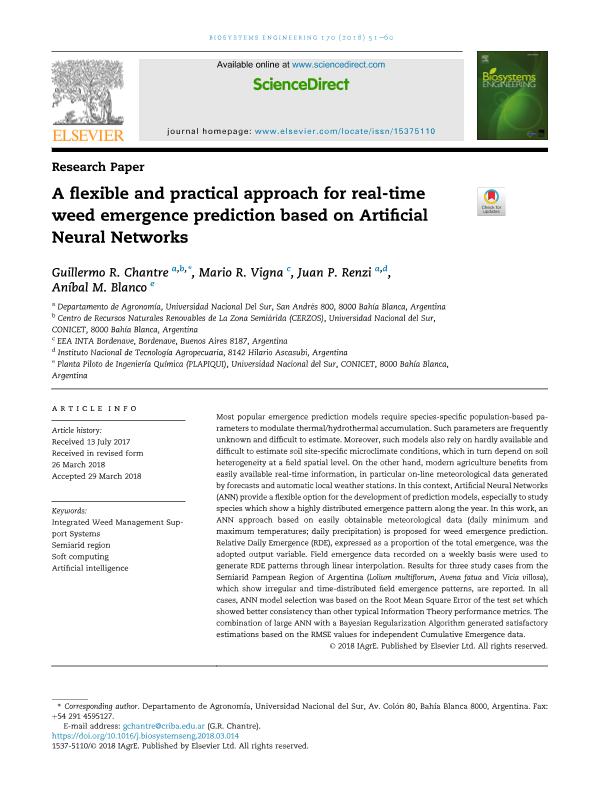Mostrar el registro sencillo del ítem
dc.contributor.author
Chantre Balacca, Guillermo Ruben

dc.contributor.author
Vigna, Mario Raul

dc.contributor.author
Renzi, Juan Pablo

dc.contributor.author
Blanco, Anibal Manuel

dc.date.available
2019-11-29T16:28:13Z
dc.date.issued
2018-06
dc.identifier.citation
Chantre Balacca, Guillermo Ruben; Vigna, Mario Raul; Renzi, Juan Pablo; Blanco, Anibal Manuel; A flexible and practical approach for real-time weed emergence prediction based on Artificial Neural Networks; Academic Press Inc Elsevier Science; Biosystems Engineering; 170; 6-2018; 51-60
dc.identifier.issn
1537-5110
dc.identifier.uri
http://hdl.handle.net/11336/90919
dc.description.abstract
Most popular emergence prediction models require species-specific population-based parameters to modulate thermal/hydrothermal accumulation. Such parameters are frequently unknown and difficult to estimate. Moreover, such models also rely on hardly available and difficult to estimate soil site-specific microclimate conditions, which in turn depend on soil heterogeneity at a field spatial level. On the other hand, modern agriculture benefits from easily available real-time information, in particular on-line meteorological data generated by forecasts and automatic local weather stations. In this context, Artificial Neural Networks (ANN) provide a flexible option for the development of prediction models, especially to study species which show a highly distributed emergence pattern along the year. In this work, an ANN approach based on easily obtainable meteorological data (daily minimum and maximum temperatures; daily precipitation) is proposed for weed emergence prediction. Relative Daily Emergence (RDE), expressed as a proportion of the total emergence, was the adopted output variable. Field emergence data recorded on a weekly basis were used to generate RDE patterns through linear interpolation. Results for three study cases from the Semiarid Pampean Region of Argentina (Lolium multiflorum, Avena fatua and Vicia villosa), which show irregular and time-distributed field emergence patterns, are reported. In all cases, ANN model selection was based on the Root Mean Square Error of the test set which showed better consistency than other typical Information Theory performance metrics. The combination of large ANN with a Bayesian Regularization Algorithm generated satisfactory estimations based on the RMSE values for independent Cumulative Emergence data.
dc.format
application/pdf
dc.language.iso
eng
dc.publisher
Academic Press Inc Elsevier Science

dc.rights
info:eu-repo/semantics/openAccess
dc.rights.uri
https://creativecommons.org/licenses/by-nc-sa/2.5/ar/
dc.subject
INTEGRATED WEED MANAGEMENT SUPPORT SYSTEMS
dc.subject
SEMIARID REGION
dc.subject
SOFT COMPUTING
dc.subject
ARTIFICIAL INTELLIGENCE
dc.subject.classification
Agronomía, reproducción y protección de plantas

dc.subject.classification
Agricultura, Silvicultura y Pesca

dc.subject.classification
CIENCIAS AGRÍCOLAS

dc.subject.classification
Otras Ciencias de la Computación e Información

dc.subject.classification
Ciencias de la Computación e Información

dc.subject.classification
CIENCIAS NATURALES Y EXACTAS

dc.title
A flexible and practical approach for real-time weed emergence prediction based on Artificial Neural Networks
dc.type
info:eu-repo/semantics/article
dc.type
info:ar-repo/semantics/artículo
dc.type
info:eu-repo/semantics/publishedVersion
dc.date.updated
2019-10-22T17:42:31Z
dc.journal.volume
170
dc.journal.pagination
51-60
dc.journal.pais
Paises Bajoas
dc.journal.ciudad
Amsterdam
dc.description.fil
Fil: Chantre Balacca, Guillermo Ruben. Consejo Nacional de Investigaciones Científicas y Técnicas. Centro Científico Tecnológico Conicet - Bahía Blanca. Centro de Recursos Naturales Renovables de la Zona Semiárida. Universidad Nacional del Sur. Centro de Recursos Naturales Renovables de la Zona Semiárida; Argentina. Universidad Nacional del Sur. Departamento de Agronomía; Argentina
dc.description.fil
Fil: Vigna, Mario Raul. Instituto Nacional de Tecnología Agropecuaria. Centro Regional Buenos Aires Sur. Estación Experimental Agropecuaria Bordenave; Argentina
dc.description.fil
Fil: Renzi, Juan Pablo. Universidad Nacional del Sur. Departamento de Agronomía; Argentina. Instituto Nacional de Tecnología Agropecuaria. Centro Regional Buenos Aires Sur. Estación Experimental Agropecuaria Hilario Ascasubi; Argentina
dc.description.fil
Fil: Blanco, Anibal Manuel. Consejo Nacional de Investigaciones Científicas y Técnicas. Centro Científico Tecnológico Conicet - Bahía Blanca. Planta Piloto de Ingeniería Química. Universidad Nacional del Sur. Planta Piloto de Ingeniería Química; Argentina
dc.journal.title
Biosystems Engineering

dc.relation.alternativeid
info:eu-repo/semantics/altIdentifier/url/http://linkinghub.elsevier.com/retrieve/pii/S1537511017306335
dc.relation.alternativeid
info:eu-repo/semantics/altIdentifier/doi/http://dx.doi.org/10.1016/j.biosystemseng.2018.03.014
Archivos asociados
